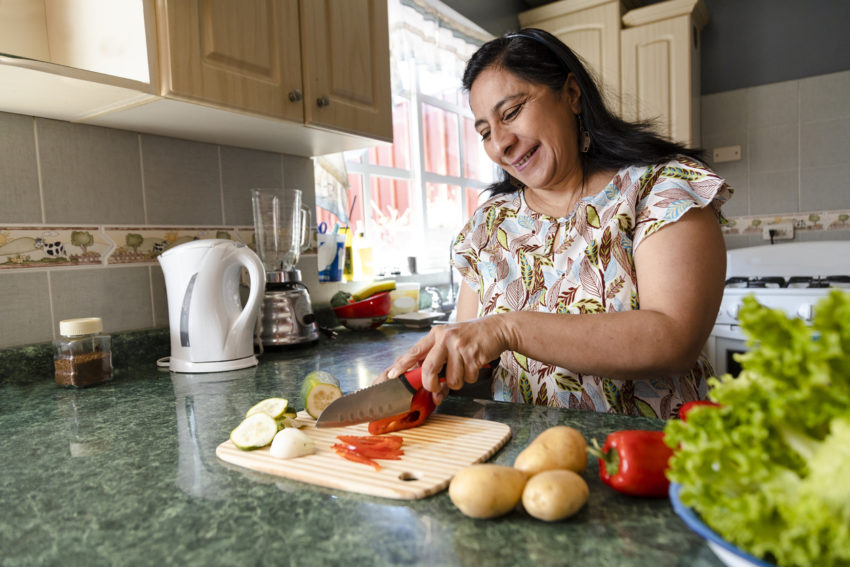
Share On Social!
New data from the American Heart Association shows that Latinos who eat healthily have healthier hearts.
This research shows that Latinos who followed a healthy dietary plan had healthier hearts in terms of structure and function.
“Healthy diet quality is an important and vital tool in the prevention of heart disease,” said lead study author David Flomenbaum, a medical student at the Albert Einstein College of Medicine in New York City. “Many of our results correspond to current knowledge about diet quality and cardiovascular health.”
The Study and Its Findings on Healthy Eating and Heart Health
Researchers evaluated over 1,800 participants in the “Echocardiographic Study of Latinos” ancillary study.
With this, they compared adherence to two popular healthy eating plans with the heart’s efficiency at pumping blood and its size and shape. This was measured through ultrasound images of the heart (echocardiograms).
This study is the largest dataset of echocardiographic parameters focused solely on U.S. Latino adults, according to the American Heart Association. This study delved into the various demographics within the Latino community, including:
- Cuban
- Puerto Rican
- Mexican
- South American
- Central American
More than half of the study participants in this analysis were female, and their average age was 56.
They implemented two different diets among participants including the:
- DASH diet (Dietary Approaches to Stop Hypertension), which is designed to help people manage their blood pressure
- AHEI (Alternative Healthy Eating Index), which measures adherence to the U.S. Department of Agriculture’s Dietary Guidelines for Americans.

“For the participants who adhered more to either of the two dietary plans, an increase in the adherence score corresponded with improved heart function and structure,” according to the researchers. “Specifically, greater adherence to either dietary plan was associated with a greater fraction of blood pumped out with each beat of the heart as measured on the echocardiogram.
“In addition, higher adherence to DASH corresponded with decreased thickness in the walls of the heart as measured on the echocardiogram, indicating better heart health,” according to the researchers.
It’s research like this that can make huge impacts on Latinos, according to lead study author Flomenbaum.
“The results underscore the importance of a healthy diet as a means of preventing heart disease, one of the leading causes of death among Hispanic and Latino people,” he said. “The association between adherence to one of the healthy eating patterns and better heart pumping function reassures us that these diet scores are associated with healthier hearts.”
Latinos and Lack of Nutrition Security
Food insecurity is prevalent in the United States, especially in Latino and Black communities.
Latino and Black households are more likely to suffer food insecurity (16.2% and 21.2%, respectively) than the national average (11.1%), according to USDA data.
“Despite their best efforts to make healthy choices in stores, three-quarters of parents reported difficulty shopping at grocery stores due to the prevalence of unhealthy foods and children’s preference for them,” Cassie Ramos, a policy associate at Center for Science in the Public Interest, in an Op-Ed in The Hill. “Junk food marketing especially targets Black and Latino children, who are more likely to view fast food advertising compared to their White peers. This trend has become more pronounced over the last several years.”
In schools, school meals are rising as a solution to both food insecurity and nutrition insecurity, especially for students of color. 
But for Latino students, many attend schools with an overabundance of unhealthy foods and sugary drinks and limited access to healthier options. Latino students ate or drank 47 more “low-nutrient” calories per day than their peers, according to a Salud America! research review.
COVID-19 has worsened food access.
“USDA is right to address the barriers of costs, time and transportation to healthy eating facing SNAP participants,” Ramos writes in an Op-Ed in The Hill. “However, USDA should also focus on the role of food industry marketing, which disproportionately targets people who participate in SNAP and others with low incomes. Consumers should not have to fight an upstream battle alone against the many factors that conspire to serve food industry profit over their health.”
What You Can Do
As expansions to SNAP begin to impact Latinos and families, policy leaders have more work to do to ensure nutrition security.
The University of Connecticut’s Rudd Center for Food Policy & Obesity offers suggestions for actions that federal, state, and local governments can take, including creating nutrition standards for kids’ meals and eliminating unhealthy food and beverage marketing to children as a tax-deductible expense.
Moreover, their recommendations include how public health advocates and practitioners can push for changes to these marketing practices.
“Develop campaigns to increase public awareness of the vast amounts of primarily unhealthy fast-food advertising, especially advertising that disproportionately targets children, teens, and communities of color,” the Rudd Center report states. “Support youth-led counter marketing campaigns to expose marketing practices by the top fast-food advertisers.”
You can also make a difference in your community’s nutrition.
Download a Salud America! Health Equity Report Card!
The report card shows many local children live in food deserts, have low food access, and get SNAP food benefits. Then you can compare it to your state and to the country.
Email your Health Equity Report Card to community leaders and share it on social media. Then use it to make the case to address food insecurity and nutrition security where help is needed most!
Explore More:
Healthy FoodBy The Numbers
142
Percent
Expected rise in Latino cancer cases in coming years



